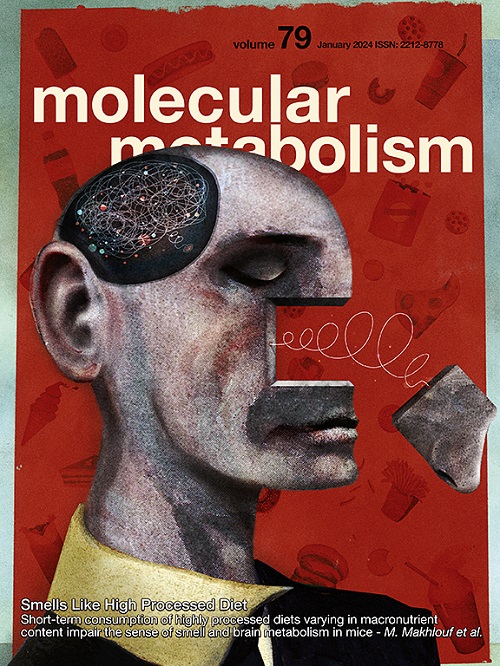CPT1C deficiency in SF1 neurons impairs early metabolic adaptation to dietary fats, leading to obesity
IF 7
2区 医学
Q1 ENDOCRINOLOGY & METABOLISM
引用次数: 0
Abstract
Objectives
SF1 neurons of the ventromedial hypothalamus (VMH) play a pivotal role in regulating body weight and adiposity, particularly in response to a high-fat diet (HFD), as well as in the recovery from insulin-induced hypoglycemia. While the brain-specific CPT1C isoform is well known for its role in controlling food intake and energy homeostasis, its function within specific hypothalamic neuronal populations remains largely unexplored. Here, we explore the role of CPT1C in SF1 neurons.
Methods
Mice deficient in CPT1C within SF1 neurons were generated, and their response to a HFD was investigated.
Results
SF1-Cpt1c-KO mice fail to adjust their caloric intake during initial HFD exposure, which is associated with impaired activation of the melanocortin system. Furthermore, these mice exhibit disrupted metabolic gene expression in the liver, muscle, and adipose tissue, leading to increased adiposity independently of food intake. In contrast, their response to glucose or insulin challenges remains intact. After long-term HFD exposure, SF1-Cpt1c-KO mice are more prone to developing obesity and glucose intolerance than control littermates, with males exhibiting a more severe phenotype. Interestingly, CPT1C deficiency in SF1 neurons also results in elevated hypothalamic endocannabinoid (eCB) levels under both chow and HFD conditions. We propose that this sustained eCB elevation reduces VMH activation by fatty acids and impairs the SF1-POMC drive upon fat intake.
Conclusion
Our findings establish CPT1C in SF1 neurons as essential for VMH-driven dietary fat sensing, satiety, and lipid metabolic adaptation.

SF1神经元缺乏CPT1C会损害对膳食脂肪的早期代谢适应,导致肥胖
目的下丘脑腹内侧(VMH)的f1神经元在调节体重和肥胖中起关键作用,特别是在高脂肪饮食(HFD)的反应中,以及在胰岛素诱导的低血糖的恢复中。虽然脑特异性CPT1C亚型因其在控制食物摄入和能量稳态中的作用而众所周知,但其在特定下丘脑神经元群中的功能仍未得到充分研究。在这里,我们探讨了CPT1C在SF1神经元中的作用。方法制备SF1神经元中CPT1C缺失的smice,观察其对HFD的反应。结果ssf1 - cpt1c - ko小鼠在初始HFD暴露期间无法调节其热量摄入,这与黑素皮质素系统的激活受损有关。此外,这些小鼠在肝脏、肌肉和脂肪组织中表现出代谢基因表达的破坏,导致肥胖增加,与食物摄入无关。相比之下,它们对葡萄糖或胰岛素的反应保持不变。长期暴露于HFD后,SF1-Cpt1c-KO小鼠比对照组小鼠更容易发生肥胖和葡萄糖耐受不良,其中雄性小鼠表现出更严重的表型。有趣的是,SF1神经元的CPT1C缺乏也会导致下丘脑内源性大麻素(eCB)水平在食物和HFD条件下升高。我们认为,这种持续的eCB升高降低了脂肪酸对VMH的激活,并损害了脂肪摄入时SF1-POMC的驱动。结论SF1神经元中的CPT1C对vmh驱动的膳食脂肪感知、饱腹感和脂质代谢适应至关重要。
本文章由计算机程序翻译,如有差异,请以英文原文为准。
求助全文
约1分钟内获得全文
求助全文
来源期刊

Molecular Metabolism
ENDOCRINOLOGY & METABOLISM-
CiteScore
14.50
自引率
2.50%
发文量
219
审稿时长
43 days
期刊介绍:
Molecular Metabolism is a leading journal dedicated to sharing groundbreaking discoveries in the field of energy homeostasis and the underlying factors of metabolic disorders. These disorders include obesity, diabetes, cardiovascular disease, and cancer. Our journal focuses on publishing research driven by hypotheses and conducted to the highest standards, aiming to provide a mechanistic understanding of energy homeostasis-related behavior, physiology, and dysfunction.
We promote interdisciplinary science, covering a broad range of approaches from molecules to humans throughout the lifespan. Our goal is to contribute to transformative research in metabolism, which has the potential to revolutionize the field. By enabling progress in the prognosis, prevention, and ultimately the cure of metabolic disorders and their long-term complications, our journal seeks to better the future of health and well-being.
 求助内容:
求助内容: 应助结果提醒方式:
应助结果提醒方式:


